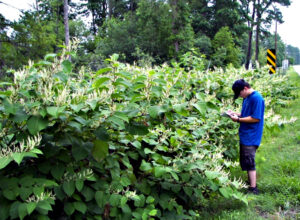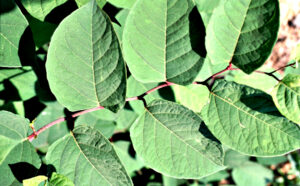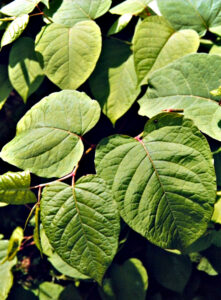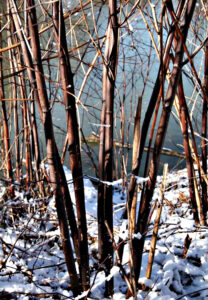
Species in the knotweed complex grow very quickly, causing large infestations on roadsides like this one. / Photo Credit: Randy Westbrooks, Invasive Plant Control, Inc., Bugwood.org
By Erika Segerson-Mueller, DNR Invasive Plant Program Specialist, Oshkosh Service Center;
Erika.SegersonMueller@wisconsin.gov or 715-492-0391
As you work on your New Year’s resolutions this year, you might want to add “don’t plant invasive species” to your list. Too wide-ranging? Try narrowing the goal to a species-specific suggestion: “Just say ‘no’ to knotweeds.”
Sometimes referred to as “the knotweed complex,” Wisconsin has three regulated species of knotweed: Japanese knotweed, giant knotweed and a hybridization known as Bohemian knotweed. Each has been found in the state.

The leaves of Japanese knotweed have a spade-like shape and are squared off at the base. / Photo Credit: John Cardina, The Ohio State University, Bugwood.org
Knotweeds are extremely quick-growing plants that can cause considerable damage and are difficult to control. While novice gardeners may jump at the opportunity to plant what they’ve heard is easy to grow, the benefits of planting a knotweed species don’t outweigh the risks.
As semi-woody perennials, knotweeds spread rapidly by sending out rhizomes (horizontal underground stems) to form large thickets that eliminate native vegetation and wildlife habitat. Knotweed grows quickly in forests, along railroad rights-of-way and waterways, often growing so dense that a hatchet is required to navigate through the plants.
Its rhizomes can reach depths of 6 feet underground. Knotweed has been known to exploit cracks and fissures in concrete and buildings. Once the plants have settled into these structural weaknesses, the roots expand, damaging pavement and foundations. Once established, knotweed stands are extremely difficult to eradicate.
Identifying Knotweeds
All three knotweed species have similar appearances. While ongoing molecular research is being done to investigate which species were present at each previously documented occurrence, a few characteristics may help you identify the knotweed complex.

Larger heart-shaped leaves that taper to a point are characteristic of the Giant knotweed species and may also be found on young Bohemian knotweed shoots. / Photo Credit: Barbara Tokarska-Guzik, University of Silesia, Bugwood.org
All three species can grow tall — between 10 and 15 feet tall. The leaves are dark green on the upper surface with a pale green underside and can vary slightly in size and shape from spade-like to heart-shaped. Overall, they are similar. Tiny, greenish-white flowers in branched sprays may be present when the species bloom during August and September.
The stems of knotweed species resemble bamboo and are smooth and hollow between swollen joints. The bamboo-like stems persevere even after the plant dies each year. Though they are killed by frost, the stems remain upright throughout the winter, making it a good time to identify the plants as they may be easy to spot standing out among the snow. Winter stems are stout and persistent and appear red or rust-colored.
Control For Knotweeds
Treatment for each of the three species is the same.
Most mechanical control methods result in vigorous resprouting, so watch treated areas carefully and plan to repeat treatments multiple times per season over several years. Recent trials indicate the best time to treat chemically (foliar application without cutting) is after the plants have flowered. For more information on knotweed control and management, check out the knotweed fact sheet from Renz Weed Science at the University of Wisconsin-Extension.
Gardeners can save themselves a lot of time and frustration by not planting knotweeds. Don’t use the plant for landscaping or share cuttings with a friend since the knotweed complex species are regulated. Neighbors don’t let neighbors plant knotweeds.
If you suspect you’ve found knotweed on your property, send photos and specific locations using GPS points, street addresses or road crossings to Invasive.Species@wisconsin.gov.

During the growing season, the stems of the knotweed species appear bamboo-like. / Photo Credit: Robert Vidéki, Doronicum Kft., Bugwood.org

The stems of the knotweed complex species persist into winter and can be easy to spot in the snow. / Photo Credit: Robert Vidéki, Doronicum Kft., Bugwood.org
